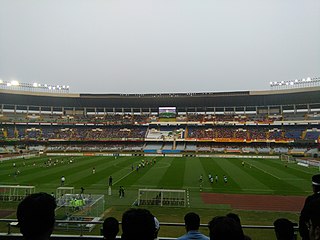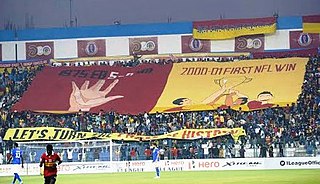
Sailendra Nath Manna, known popularly as Sailen Manna, was an Indian football player who represented the India national team between 1948 and 1956. Predominantly played as a left-back, Manna is considered as one of the best defenders the country has ever produced. He has represented and captained India in different international competitions, including the Olympics and Asian Games. In 1971 Manna was awarded with Padma Shri by Government of India.
Subhash Bhowmick was an Indian football player and manager. During his playing career, he represented the "Big Two" of Kolkata football, East Bengal and Mohun Bagan. He also represented India in various international tournaments between 1970 and 1985.

Subimal "Chuni" Goswami was an Indian professional footballer and first-class cricketer. As footballer, he played as a striker or winger, captained both the Mohun Bagan club and the India national team. He also served as the Sheriff of Kolkata. Goswami scored 12 goals in 37 international appearances. He was an Olympian, represented India national team at the 1960 Summer Olympics. He also led the team to achieve the gold medal at the 1962 Asian Games, and earn the runners-up position at the 1964 AFC Asian Cup.
Chima Ephraim Okorie is a Nigerian former professional football striker who was renowned for his goalscoring prowess in the Indian leagues. He went on to score 131 goals for East Bengal in three seasons, becoming the top scorer in the history of East Bengal crossing K. P. Dhanaraj who had 127 goals, until it was crossed by Bhaichung Bhutia.
Krishanu Dey was an Indian footballer from Kolkata, India. He was an attacking midfielder and was known as the "Indian Maradona" among his fans due to his footballing skills and playing style.
Sudip Chatterjee, nicknamed Tulu, was an Indian international football player and coach. He started his career as a centre back and then moved to the right back position before switching to the midfielder role. As a midfielder, he was considered among the finest players in Indian football. He also managed Bengal in Santosh Trophy and won the 1998–99 edition.

Sheoo Mewalal was an Indian footballer in Kolkata. He played as a striker and was known for his fitness, bicycle kicks, and goal-scoring abilities, especially using the rabona kick.
Amal Dutta was a former Indian footballer, coach and football manager. Born in Calcutta, then Bengal Presidency, he is considered as the first professional football coach in the country. A finest thinker of the sport, Dutta had a rivalry with Pradip Kumar Banerjee during his coaching days in Kolkata club football.

Aryan Football Club is an Indian professional multi-sports club based in Kolkata, West Bengal, known predominantly for its association football section. The club competes in the Calcutta Football League, oldest league in Asia.

The Kolkata Derby is the football match in Kolkata, between Mohun Bagan and East Bengal. The rivalry between these two teams is over 100 years old, and the matches witnessed large audience attendance and rivalry between patrons. It is considered to be one of the biggest Asian footballing rivalry. The first match was played on 8 August 1921 in Cooch Behar Cup and latest match of this historical derby was played on 19 October 2024 in Indian Super League. The Kolkata Derby is considered to be greatest derby in Asian Football and also one of the biggest derbies in the world.

Samar "Badru" Banerjee was an Indian footballer who played primarily as a striker for the India national football team. He captained India at the 1956 Summer Olympics in Melbourne, where they achieved fourth place.

Kalyani Stadium is a stadium in Kalyani, West Bengal, India. The stadium holds 20,000 spectators. Currently the stadium is being re-modelled with modern structure and 5-storied gallery with added facilities. It usually hosts matches of I-League and Calcutta Football League.

Balaidas Chatterjee was an Indian footballer and football manager, who played predominantly as defender. He became the first head coach of the India national team and guided them at the 1948 Summer Olympics in London. During his playing days, Chatterjee played for Mohun Bagan in various domestic competitions.
Narayanswami Ulaganathan is an Indian former footballer. He played for Mohun Bagan in three spells, East Bengal, Mohammedan and the India national team primarily as a winger, during his 12-year career as a professional footballer.
Shyam Thapa is an Indian former footballer and coach. He represented the India national football team and was the bronze-medallist at the 1970 Asian Games. He later went on to manage the Nepal national football team.
Sukalyan Ghosh Dastidar was an Indian professional footballer from Jalpaiguri, who played as a striker for the India national football team, alongside Mohun Bagan and East Bengal. He also represented Bengal in Santosh Trophy.

The 1945 IFA Shield Final was the 53rd final of the IFA Shield, the second oldest football competition in India, and was contested between Kolkata giants East Bengal and Mohun Bagan on 9 August 1945 at the Calcutta Ground in Kolkata.









